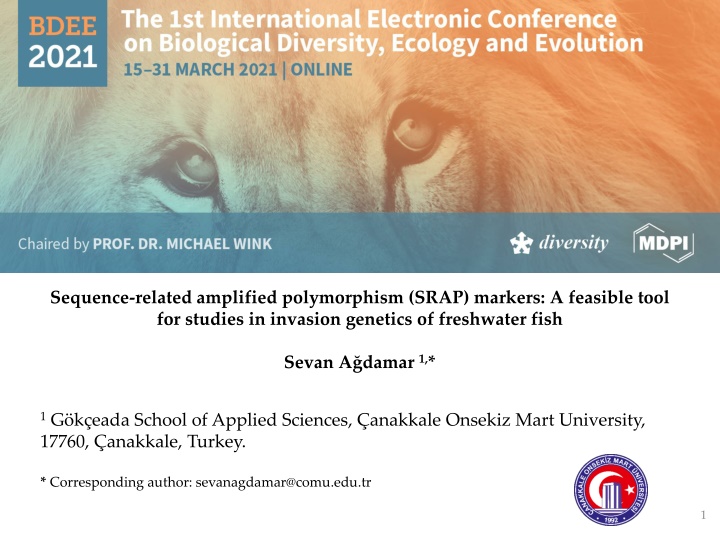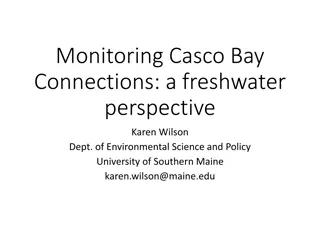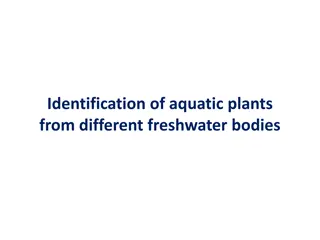SRAP Markers: Feasible Tool for Invasion Genetics of Freshwater Fish
Molecular tools, like Sequence-Related Amplified Polymorphism (SRAP) markers, play a crucial role in studying invasion genetics of freshwater fish. SRAPs offer a reliable and efficient way to assess genetic diversity and variations in non-native species, aiding in population genetics studies of invasive species. This presentation highlights the significance of SRAP markers in detecting genetic polymorphism and variation for invasion genetics research.
Download Presentation

Please find below an Image/Link to download the presentation.
The content on the website is provided AS IS for your information and personal use only. It may not be sold, licensed, or shared on other websites without obtaining consent from the author.If you encounter any issues during the download, it is possible that the publisher has removed the file from their server.
You are allowed to download the files provided on this website for personal or commercial use, subject to the condition that they are used lawfully. All files are the property of their respective owners.
The content on the website is provided AS IS for your information and personal use only. It may not be sold, licensed, or shared on other websites without obtaining consent from the author.
E N D
Presentation Transcript
Title of the Presentation Sequence-related amplified polymorphism (SRAP) markers: A feasible tool for studies in invasion genetics of freshwater fish Sevan A damar1,* 1 G k eada School of Applied Sciences, anakkale Onsekiz Mart University, 17760, anakkale, Turkey. * Corresponding author: sevanagdamar@comu.edu.tr 1
Abstract: Molecular tools can effectively be used in diagnosis, identification, management, and most especially detection of invasion pathways and originations of introduced species. It would provide helpful information for a better conception of the events essential for a successful colonization by comparing genetic differentiation of a species among its native and invasive habitats. PCR-based marker techniques, such as RAPD, AFLP and ISSR have been used for studying genetic diversity, taxonomy and phylogeny of the species, but they are generally used for estimating more limited levels of genetic variation. Although the potential for these molecular markers to generate helpful data, researchers have been suspicious to use them resulting from technical deliminations. A more recently developed molecular marker system, Sequence-Related Amplified Polymorphism (SRAP) is easy, reliable, middle- yield, high-dominant total, and iterative way on genetic variation of different species. Like other molecular markers, SRAPs can also be used for assessing invasion genetics of non-native species and their use to discover variations in genetic structure of native and invasive freshwater fish has been starting common. Depends on the rapidly growing body of the literature, we suggest that the SRAPs could, and should, be applied to the subjects of invasion genetics. The aim of this study was to reveal the potential for SRAP markers in invasion genetics of freshwater fish. Results from SRAP products may prove to be significant for discovery of polymorphism and genetic variation for studies in population genetics of invasive species. Keywords: genetic diversity; polymorphism; invasion; molecular markers; non-native species. 2
Results and Discussion The scale of colonization has significant genetic outcomes as the amounts and types of genetic variation carried from one place to another can affect the possibility of successful establishment, future dispersion and evolutionary process. In concert with advances in molecular methods for investigate genetic diversity and the development of a rapid growing of evolutionary theory related to evolutionary approaches in colonizing populations, it caused the arise of invasion genetics. Nowadays, through the usage of molecular marker systems, we are in a better by far position to understand the migratory history of invasions and evaluate the importance of genetic bottlenecks and founder effects. The wide range of molecular markers that can simply be used in population genetics is quite common. Molecular markers applied to study genetic variations of freshwater fish include detecting polymorphisms in DNA sequence, the use of DNA hybridization methods to determine RFLPs, or the use of PCR-based technology to reveal polymorphism using RAPD, SSR, or AFLP. Various molecular markers, each with their own advantages and disadvantages have been identified. For instance, RFLPs can be useful for detecting polymorphisms in the genome. However, this marker needs large amounts of DNA, and is expensive, time-consuming, and hard to optimize. The application of RAPD markers in phylogenetic studies between the distantly related species or genus is a main problem because markers are non-locus specific. Like SSRs, the AFLPs can be optimized. The methodology is somewhat prone to empirical errors like RAPDs, and its cost and time required are prevents to its broader approval by the scientific environments. At this point, SRAPs have demonstrated the talent to detect genetic variation at a several of taxonomic levels, and are also often used for molecular analyses of within and between populations. 3
Results and Discussion Various comparative works have found SRAPs provide a better levels of variation to other markers, but with considerably less experimental effort and cost for preferable levels of polymorphism and reproducibility. In this respect, SRAP markers can also be used for understanding invasion genetics of freshwater species and their use to explore variations in genetic characteristics of native and non-native freshwater fish has been starting common. For instance, researchers used SRAPs to differentiate cultured populations in grass carp Ctenopharyngodon idella. They identified eight SRAP fragments that high similarities to functional genes. More recently, scientists tested ISSRs and SRAPs for genetic characterization of invasive populations of gibel carp Carassius gibelio. Both markers showed that gene flow level among populations is low and that genetic differentiation level is high. The results also indicate that the existence of invasive populations of gibel carp is the result of several introduction events originating from different sources. Consequently, SRAP markers can successfully determine genetic diversity and find out the origin and distribution of invasive species, such as introduced freshwater fish. 4
Conclusion Although early recognition of the potential benefits of genomic tools for studying biological invasions, the improvement of molecular technologies and resources for invasive species has been lagged. Various molecular marker systems and constantly improving experimental approaches have been developed to reveal the invasion histories. In consequence of this developments, SRAP markers could, and should, be applied in studies on population genetics of invasive species. Findings from SRAP products may prove to be significant for investigation of polymorphism and improvement of new variable loci for investigations in invasion biology. 5























